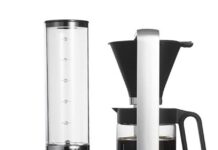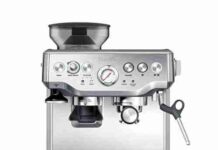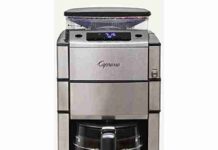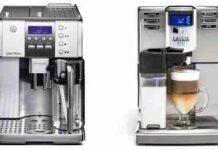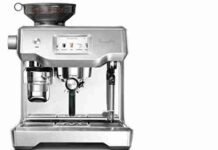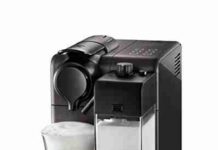
Coffee lovers everywhere rejoice when they take that first sip of their morning brew, but many may not realize that lurking in their beloved coffee machine could be the unsightly and potentially harmful presence of mold.
Mold can quickly develop in a coffee machine if not correctly cleaned and maintained, particularly in a dark, damp, and warm environment when left unattended for long periods. This article will explore the various factors contributing to mold growth in coffee machines, from water temperature to residue buildup, providing tips and solutions to prevent this unwanted invader from ruining our favorite morning ritual.
Poor Cleaning Habits
Having poor cleaning habits when it comes to your coffee machine can lead to mold buildup. Regular cleaning is essential to prevent the growth of mold and bacteria. Neglecting to clean your machine can create a buildup of coffee residues, oils, and mineral deposits. These substances create the perfect environment for mold to thrive. Therefore, it is essential to establish a routine cleaning schedule and make it a habit to clean your coffee machine properly.
Moisture Buildup
Moisture buildup inside your coffee machine can contribute to mold growth. When brewing coffee, the machine produces steam and condensation. If this moisture is not adequately dried or drained, it can accumulate, creating a damp environment that promotes mold growth. Ensuring that your coffee machine has proper drainage and ventilation is essential to prevent moisture from lingering and causing mold problems.
Stagnant Water
Leaving stagnant water in the reservoir of your coffee machine can be a breeding ground for mold. When the water is not drained or refreshed regularly, it becomes a stagnant pool where bacteria and mold can proliferate. To avoid this, emptying and cleaning the water reservoir after each use is crucial. Always use fresh water for brewing, and never let the water sit for extended periods.
Lack of Ventilation
Insufficient ventilation in your coffee machine can contribute to moisture buildup and mold growth. Without proper airflow, the inside of the machine can become a warm and humid environment, providing an ideal breeding ground for mold. Ensuring that the machine has sufficient ventilation is essential to allow for proper air circulation and prevent moisture accumulation.
Leaking or Damaged Seals
Leaking or damaged seals in your coffee machine can allow water to seep into areas where it shouldn’t, leading to hidden moisture pockets and the growth of mold. Regularly inspect your coffee machine for any signs of leaking or damaged seals and promptly address the issue to prevent mold from developing. Ensuring all seals are intact and functioning properly will help maintain a dry, mold-free environment.
Dirty Water Reservoir
A dirty water reservoir can be a breeding ground for mold. The combination of old, stagnant water and the presence of organic matter from previous brew cycles can create an ideal habitat for mold growth. It is essential to regularly clean and sanitize the water reservoir to eliminate any potential mold spores. Additionally, using filtered water can help reduce the chances of mold growth in your machine.
Infrequent Cleaning
Infrequent cleaning of your coffee machine can contribute to mold buildup. Over time, coffee oils and residues accumulate inside the machine, providing a food source for mold. This can result in the formation of mold colonies that are not only unsightly but also compromise the taste and quality of your brew. Regular cleaning, including descaling and removing any visible buildup, is crucial to prevent mold growth and maintain the performance of your coffee machine.
High Humidity Environment
Operating your coffee machine in a high-humidity environment can increase the risk of mold growth. Humid conditions promote moisture retention and create an environment where mold can thrive. If you live in an area with high humidity, consider using a dehumidifier or relocating your coffee machine to a drier area of your home. This will help minimize the chances of mold growth and maintain a clean and safe brewing environment.
Improper Storage
Improper storage of your coffee machine can contribute to mold growth. Storing it in a damp or humid location, such as a basement or a cabinet without proper ventilation, can create a favorable environment for mold to develop. It is essential to store your coffee machine in a cool, dry place with adequate airflow. This will help prevent moisture buildup and minimize the risk of mold growth.
Using Unfiltered Water
Using unfiltered water in your coffee machine can introduce impurities and contaminants that promote mold growth. Tap water often contains minerals and chlorine, creating a breeding ground for mold. Consider using filtered water through a built-in filter in your coffee machine or a separate water filtration system. Filtered water will not only improve the taste of your coffee but also reduce the likelihood of mold formation.
In conclusion, poor cleaning habits, moisture buildup, stagnant water, lack of ventilation, leaking or damaged seals, dirty water reservoirs, infrequent cleaning, high humidity environments, improper storage, and using unfiltered water can all contribute to mold buildup in a coffee machine. By adopting good cleaning practices, ensuring proper drainage and ventilation, regularly inspecting and maintaining the machine, using filtered water, and storing it correctly, you can prevent mold growth and enjoy a clean and delicious cup of coffee every time.


